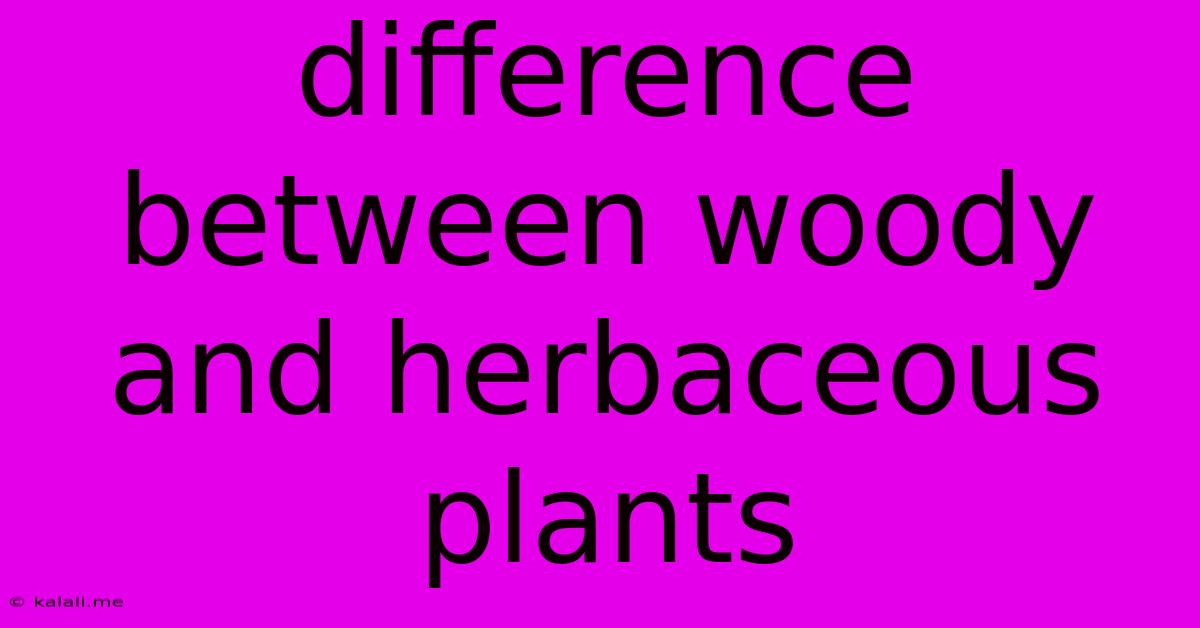Difference Between Woody And Herbaceous Plants
Kalali
Jun 12, 2025 · 3 min read

Table of Contents
Woody vs. Herbaceous Plants: A Comprehensive Guide
Knowing the difference between woody and herbaceous plants is fundamental for any gardener, botanist, or nature enthusiast. While both are integral parts of the plant kingdom, their distinct characteristics set them apart in terms of structure, lifespan, and overall appearance. This article will delve into the key differences between these two plant types, clarifying their defining features and providing examples to enhance your understanding. Understanding these differences can help you choose the right plants for your garden, landscape, or even scientific study.
What are Woody Plants?
Woody plants are characterized by their lignified tissues, meaning they possess hard, woody stems and branches. This lignification results from the deposition of lignin, a complex polymer that provides structural support and rigidity. This tough, durable structure allows woody plants to grow taller and live longer than their herbaceous counterparts. Their growth is often perennial, meaning they survive year after year, continuing to grow and develop.
Key Characteristics of Woody Plants:
- Hard, woody stems: These stems contain a significant amount of lignin, giving them strength and durability.
- Long lifespan: Many woody plants live for decades, even centuries.
- Secondary growth: They undergo secondary growth, increasing in girth as they age, forming a visible trunk and branches.
- Perennial growth: They typically survive winter and continue growing the following year. This doesn't mean all woody plants are evergreen; many are deciduous, shedding their leaves seasonally.
- Examples: Trees (oaks, pines, maples), shrubs (roses, azaleas, rhododendrons), vines (grapes, ivy).
What are Herbaceous Plants?
Herbaceous plants, in contrast to woody plants, lack persistent woody stems above ground. Their stems are typically soft, green, and flexible. While some herbaceous plants may have some woody tissues at their base, they don't develop the strong, lignified structure of woody plants.
Key Characteristics of Herbaceous Plants:
- Soft, non-woody stems: Their stems are usually green and flexible.
- Shorter lifespan: Many herbaceous plants are annuals (completing their life cycle in one year) or biennials (completing their life cycle in two years). Perennial herbaceous plants die back to the ground each year, but their roots survive to send up new shoots in the spring.
- No secondary growth: They don't significantly increase in girth.
- Seasonal growth: They may die back to the ground during winter and re-sprout in spring.
- Examples: Sunflowers, marigolds (annuals), carrots, parsley (biennials), hostas, lavender (perennials).
The Table Summarizes the Key Differences:
| Feature | Woody Plants | Herbaceous Plants |
|---|---|---|
| Stems | Hard, woody, lignified | Soft, non-woody, green |
| Lifespan | Long (years, decades, centuries) | Short (annual, biennial, perennial) |
| Growth | Secondary growth, increases girth | Limited or no secondary growth |
| Winter Survival | Survives winter, may be deciduous or evergreen | Dies back to the ground annually (for annuals & biennials) or survives winter below ground (for perennials) |
Beyond the Basics: Exceptions and Overlaps
While these distinctions are generally clear, some exceptions exist. Some plants exhibit characteristics of both woody and herbaceous plants. For example, certain shrubs might have partly woody stems, blurring the line between categories. The classification can also be influenced by environmental factors and species-specific adaptations.
Understanding the fundamental differences between woody and herbaceous plants is crucial for effective gardening, landscape design, and botanical studies. By grasping their key characteristics, you can make informed choices about plant selection and cultivation, leading to a thriving and successful garden.
Latest Posts
Latest Posts
-
5 Miles Is How Many Meters
Jun 13, 2025
-
What Is Cube Root Of 4
Jun 13, 2025
-
Which Of The Following Statements Best Describes
Jun 13, 2025
-
What Is The Roman Numeral Lviii
Jun 13, 2025
-
Which Of The Following Best Describes An Intranet
Jun 13, 2025
Related Post
Thank you for visiting our website which covers about Difference Between Woody And Herbaceous Plants . We hope the information provided has been useful to you. Feel free to contact us if you have any questions or need further assistance. See you next time and don't miss to bookmark.